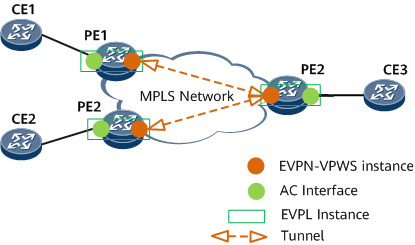Configuring EVPN VPWS over MPLS Functions
EVPN VPWS over MPLS allows you to establish P2P MPLS tunnels between PEs and implement the P2P L2VPN function.
Usage Scenario
EVPN VPWS provides a P2P L2VPN service solution based on the EVPN service architecture. Regarding this solution, a P2P MPLS tunnel is established between PEs and traverses the backbone network. By binding the AC interface on the user side to the P2P MPLS tunnel on the network side, traffic can be transmitted between the AC interface and the P2P MPLS tunnel. As a result, traffic that enters the AC interface is forwarded directly to the peer PE through the P2P MPLS tunnel. This solution provides a simple Layer 2 packet forwarding mode for the connection between AC interfaces at both ends, avoiding the need to search MAC address entries. This service solution is named Ethernet Line (E-Line).
The basic EVPN VPWS architecture has the following components:
- AC: access circuit. An AC is an independent link or circuit that connects a CE to a PE. An AC interface can be a physical interface or a logical interface. AC attributes include the encapsulation type, maximum transmission unit (MTU), and interface parameters of a specified link type.
- EVPN VPWS instance: An EVPN VPWS instance is deployed on an edge PE and contains services that have the same access-side or network-side attributes. Routes are transmitted based on the RD and RT configured in each EVPN VPWS instance in a BGP EVPN address family.
- EVPL instance: An EVPL instance corresponds to an AC. Each EVPL instance has a service ID. An EVPL instance on the local PE corresponds to an EVPL instance on the remote PE. PEs exchange EVPN routes carrying a service ID to construct forwarding entries that are used to forward or receive service traffic from different ESs, achieving P2P interworking.
- Tunnel: network-side MPLS tunnel.

Pre-configuration Tasks
Before configuring EVPN VPWS over MPLS, enable route reachability on an IPv4 network.
- Configuring EVPN Functions
- EVPN VPWS is established based on the EVPN service architecture. Before configuring EVPN VPWS over MPLS, you need to configure EVPN functions.
- (Optional) Configuring the Global Redundancy Mode
- A PE's global redundancy mode determines whether the PE can work with other PEs in load-balancing mode.
- Configuring an EVPL Instance
- To bind an AC interface on the user side to an MPLS tunnel interface on the network side, create an EVPL instance first.
- Configuring an AC Interface
- In MPLS E-Line scenarios, a Layer 2 sub-interface can function as an AC interface, and traffic encapsulation can be configured on the AC interface to transmit different types of data packets.
- Configuring an MPLS LDP Tunnel
- EVPN E-Line uses P2P MPLS LDP tunnels to traverse the backbone network. This section describes how to configure an MPLS LDP tunnel.
- (Optional) Configuring a DF Election Mode for EVPN VPWS
- In an EVPN VPWS over MPLS scenario where a CE is multi-homed to PEs in single-active mode and no E-Trunk is configured, DF election needs to be performed between the PEs to determine the active/standby status of the PEs.
- (Optional) Setting a Redundancy Mode and DF Priority per ESI Instance
- In a scenario where multiple CEs are dual-homed to PEs, if you want to use different transmission modes (load balancing and non-load balancing) to send unicast traffic to different CEs or if you want to specify DFs for traffic forwarding by setting priority values, you can set a redundancy mode and DF priority values based on ESIs.
- (Optional) Configuring FRR
- In EVPN VPWS over MPLS multi-homing single-active scenarios, FRR needs to be configured to prevent traffic loss if the primary PE fails.
- Verifying the Configuration
- After configuring EVPN VPWS over MPLS, check EVPL instance information.